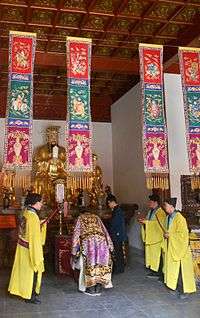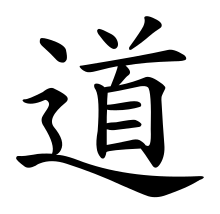Zhengyi Dao
Zhengyi Dao (Chinese: 正一道; pinyin: Zheng Yi Dào) or the Way of Orthodox Unity is a Chinese Daoist movement that emerged during the Tang dynasty as a transformation of the earlier Tianshi Dao movement. Like Tianshi Dao, the leader of Zhengyi Daoism was known as the Celestial Master.

| Part of a series on |
| Taoism |
|---|
 |
|
Practices
|
|
Deities |
|
Organisations |
History
By the beginning of the Tang dynasty in 618, the term 'Celestial Master' had lost the potency it had in earlier movements such as the Five Pecks of Rice, and any prominent Daoist could be accorded the title.[1] Emperor Xuanzong (712-756) canonized the first Celestial Master Zhang Daoling during his reign. This did not benefit the original territory of his followers in Sichuan, but rather benefited a temple in the Jiangnan area of Jiangxi province. This temple, located at Mount Longhu, claimed to be the spot where Zhang Daoling had obtained the Tao, and where his descendants still lived. Recognized by the emperor as the legitimate descendants of Zhang Daoling, these new Celestial Masters established a new patriarchy at their base of Longhu Shan.[2]
The importance of the Zhengyi school grew during the Song dynasty, with the Celestial masters frequently receiving imperial appointments. In 1239, the Southern Song dynasty's Emperor Lizong commanded the 35th Celestial Master Zhang Keda to the united Lingbao School, the Shangqing School and Zhengyi Dao. The new school was to retain the Zhengyi name and remain based at Mount Longhu. Shortly after the schools were united, the Mongols under Kublai Khan conquered the Southern Song dynasty and established the Yuan dynasty in China. He accepted the claim that the Celestial Master of Mount Longhu was descended from Zhang Daoling and granted the school the right to control affairs relating to Daoism in the Jiangnan area. In 1304, as a result of Zhengyi Dao's increased importance under the Mongols, all of the Daoist schools, with the exception of the Quanzhen School, were united under the banner of the Zhengyi School, with the 38th Celestial Master, Zhang Yucai, as leader.[3]
The founding of the Ming dynasty in 1368 marked the beginning of a long decline in the power of the Zhengyi Daoism. The first Ming ruler, the Hongwu Emperor (1368–98), suppressed the use of the title of 'Celestial Master' among the Zhengyi School, and the 50th Celestial Master Zhang Guoxiang had his title stripped by the Longqing Emperor (1567–72).[4] By the Daoguang period (1821–50) of the Qing dynasty, relations between the court and the Celestial Masters came to an end. The school's activities became localized to regions in which the school was particularly important.[5] Despite ending association with the court, the Celestial Master himself still retained a great deal of prestige and importance among Daoists throughout China.[6] This prestige, which arose from the belief that he was descended from Zhang Daoling, was evident when the Celestial Master traveled and attracted crowds of people wherever he went.[7]
Beliefs
Unlike prior incarnations of the Celestial Masters, like the school based at Louguan, the Zhengyi Daoists did not venerate Laozi as a god. Instead, he was viewed as the ancestor of the school's teaching.[8]
Practices
During the Tang dynasty, the primary activity of Zhengyi Daoists was to sell protective talismans. Local cults developed around the sale of these talismans, and around guilds and associations patronized by members of the church.[9]
One of the fundamental practices of the school was conferring registers (lu) upon people entering Daoism. A register was a way to allow that the Daoist tradition passed on to future generations by ensuring those who received them had an adequate knowledge of the school's teachings.[8] Registers also had the names of deities written on them who could be called upon by the bearer to assist in times of need.[10] Once one received a register, they were considered to be part of the priesthood. There were different grades of registers for laypeople with differing levels of religious knowledge.[8]
The Celestial Masters adopted the Thunder Rites during the last two decades of the Northern Song dynasty. The Five Thunders variety appeared earlier and was linked with the Celestial Masters.
Rituals
There are two main types of rituals performed by the Zhengyi Daoists the jiao (Offering) and zhai (Retreat) rituals.[8] The zhai ritual is performed as a way to gain benefits through purification and abstinence, and usually takes place immediately before the jiao ritual. In performing a ritual, an adherent must first recite a litany of repentance, then notify the deities of the merits gained through repentance by submitting a document to heaven. Upon completion of the zhai ritual, the jiao ritual begins in which deities are given offerings and thanked.[11] The jiao ritual is usually performed over a three-day period. Much of the ritual is performed by priests in a temple, but can also involve religious processions through the city, musical performances and a mass offering in front of the temple.[12]
Texts
The Zhengyi Daoists were particularly notable for their work in gathering Daoist texts and assembling them into collections. Zhang Yuchu (1361–1410) received an imperial commission in 1406 to gather texts, in particular those produced during the reign of the Hongwu Emperor (1368–98). With these texts, Zhang compiled a reference work known as the Zhengtong Daozang (Canon of the Zhengtong Reign), which was an overview of current Daoists texts and practices.[13] Zhang Guoxiang (?-1611), compiled a similar reference work in 1607 known as the Wanli Xu Daozang (Supplementary Daoist Canon of the Wanli Reign Period).[14]
Notes
- Kleeman (2008), p. 686.
- Schipper & Verellen (2004), p. 634.
- Chen (2008), p. 1258-1259.
- Boltz (2008), p. 1226.
- Chen (2008), p. 1260.
- Goossaert (2004), p. 125-126.
- Goossaert (2004), p. 128.
- Chen (2008), p. 1259.
- Robinet (1997), p. 78.
- Miller (2008), p. 41.
- Toshiaki (2008), p. 1217.
- Andersen (2008), p. 539.
- Boltz (2008), p. 324.
- Boltz (2008), p. 1226-1227.
References
- Andersen, Poul. "Jiao." in Fabrizio Pregadio, ed., The Encyclopedia of Taoism (London: Routledge, 2008), 539-544.
- Boltz, Judith. "Daomen Shigui." in Fabrizio Pregadio, ed., The Encyclopedia of Taoism (London: Routledge, 2008), 1226-1227.
- Boltz, Judith. "Zhang Guoxiang." in Fabrizio Pregadio, ed., The Encyclopedia of Taoism (London: Routledge, 2008), 1226-1227.
- Chen, Yaoting. "Zhengyi." in Fabrizio Pregadio, ed., The Encyclopedia of Taoism (London: Routledge, 2008), 1258-1260.
- Goossaert, Vincent. "Bureaucratic charisma: The Zhang Heavenly Master institution and court Taoists in late-Qing China," Asia Major 17.2 (2004), 121-159.
- Kleeman, Terry. "Tianshi Dao." in Fabrizio Pregadio, ed., The Encyclopedia of Taoism (London: Routledge, 2008), 981-986.
- Miller, Amy Lynn. "Lu." in Fabrizio Pregadio, ed., The Encyclopedia of Taoism (London: Routledge, 2008), 40-42.
- Robinet, Isabelle. Taoism: Growth of a Religion. Stanford: Stanford University, 1997.
- Schipper, Kristopher and Franciscus Verellen. The Taoist Canon: A Historical Companion to the Daozang. Chicago: University of Chicago, 2004.
- Toshiaki, Yamada. "Zhai." in Fabrizio Pregadio, ed., The Encyclopedia of Taoism (London: Routledge, 2008), 1216-1217.
External links
- The Taoist Association of Celestial Master Chang Website of 65th Celestial Master (claimant)